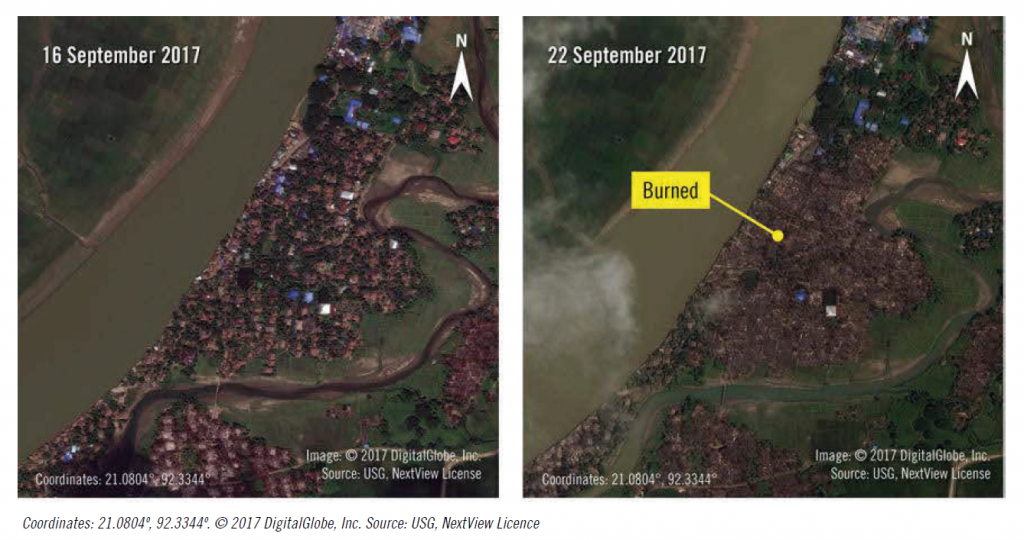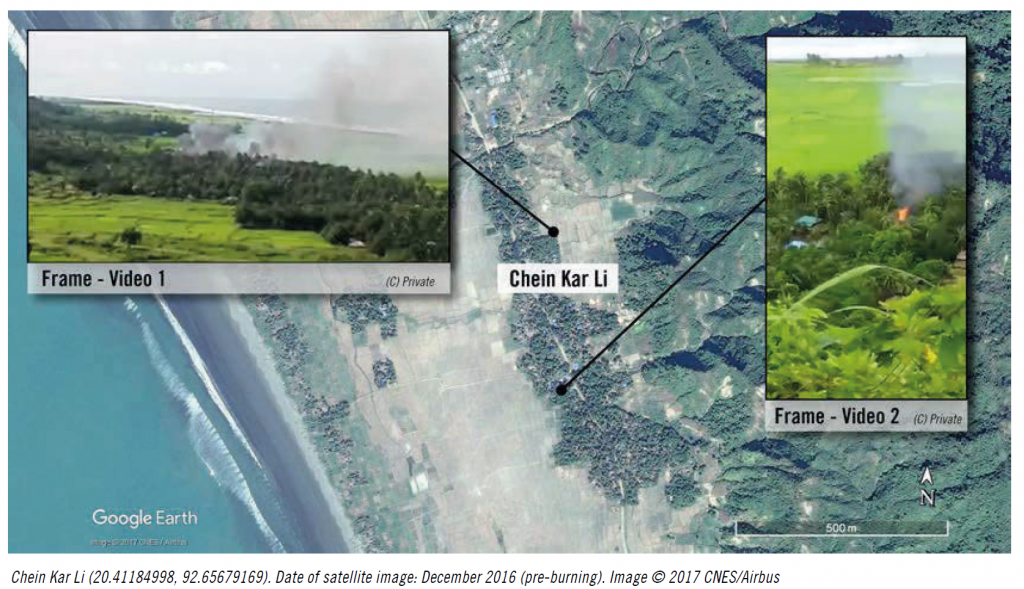Secondary menu
Ethnic Cleansing in Rakhine State: Law Students Assist Amnesty International with Digital Verification in Myanmar
Bethanie Pascutto (3L)

Before and after satellite images of a village in Rakhine State
Over the past two years, more than 900,000 Rohingya have fled Myanmar’s Rakhine State across the Naf River into southwestern Bangladesh. In response to a campaign of ethnic cleansing perpetrated by the Myanmar military, 530,000 men, women and children made this journey between August and October of this year alone. Photos and videos of this horrific humanitarian crisis have flooded the internet, making visible the suffering of the Rohingya people. In an age where technology is an asset to human rights monitoring and advocacy, the ability to verify digital content is crucial. Such evidence is essential to hold those responsible for human rights’ abuses accountable.
The International Human Rights Program’s Digital Verification Corps (DVC) at the University of Toronto’s Faculty of Law is doing just that for Amnesty International researchers. The DVC is a network of volunteers that reviews and verifies digital content, including pictures and videos of alleged human rights abuses. This content is often posted by civilians caught in a conflict zones that cannot be easily accessed by advocacy organizations. The DVC mitigates these challenges by assessing the credibility of sources, gathering external information, and evaluating markers of authenticity.
Much of the DVC’s work this year has been focused on the humanitarian crisis unfolding in Myanmar. The Rohingya people are an ethnic minority who have long faced discrimination and persecution by the Burmese government. The vast majority of Rohingya are from the Rakhine State in Myanmar. Prior to the military crackdowns and resultant refugee crises of the past two years, the Rohingya population in Myanmar was about 1.3 million. The Myanmar military began a renewed campaign of ethnic cleansing against the Rohingya population in August, 2017, after members of an armed Rohingya group attacked about 30 security outposts in northern Rakhine State. In this latest round of violence, the Myanmar military has killed unknown numbers of Rohingya, subjected Rohingya women and girls to sexual violence, and burned entire villages in the region.
As Amnesty International researchers have not been granted access to Rakhine State, it has been difficult for the organization to acquire first-hand evidence of the atrocities. In addition to interviews conducted with Rohingya refugees in Bangladesh, Amnesty International has relied on an analysis of satellite imagery and data, as well as dozens of photographs and videos taken inside Rakhine State. The DVC groups from the University of Toronto and the University of California, Berkeley reviewed and verified the authenticity of this digital content. Specifically, the DVC undertook a lengthy process of ‘geolocation’ to pinpoint villages destroyed by the Myanmar military in vast and remote areas of the Rakhine State. For example, after poring over satellite images from Google Earth and matching them to content taken inside Rakhine State, the DVC was able to identify before and after images of Chein Kar Li that established the village had been razed in August 2017.
The DVC’s efforts contributed to Amnesty International’s report released in October detailing atrocities perpetrated by the Myanmar military. “‘My World Is Finished’: Rohingya Targeted in Crimes against Humanity in Myanmar” documents crimes against humanity taking place in Myanmar, including unlawful killings, deportation and forcible displacement, torture, rape and other forms of sexual violence, persecution based on ethnic and religious grounds, looting, denial or severe restrictions on humanitarian aid and other inhumane acts. Amnesty International is using the report in its advocacy efforts directed at Myanmar, the United Nations, the European Union, the Association of Southeast Asian Nations, and the international community as a whole. The report has received extensive media coverage across the world and prompted the international community to face the reality of what is happening in the Rakhine state.

Satellite image of Chein Kar Li matched to two videos taken in the village
Note: The International Human Rights Program’s Digital Verification Corps was profiled in the September 2017 issue of Rights Review (see The Next Generation of Human Rights Researchers: U of T Students Hone their Digital Verification Skills).
